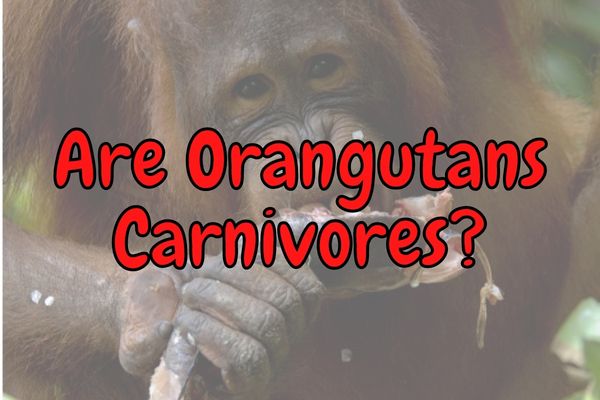Orangutans are intelligent, long-lived primates that are found in the rainforests of Indonesia and Malaysia. These gentle giants spend most of their time in the trees, where they build nests to sleep in at night and forage for food during the day.
Orangutans are omnivores like humans. This means that they eat both plants and animals. In the wild, orangutans mainly eat fruit, leaves, and other plant material, but they will also snack on insects. They have even been observed to eat larger animals like fish and other primates!
Contents
What are Orangutans and where do they live?
Orangutans are classified as apes, or anthropoids. They live mainly in the rain forests of Borneo and Sumatra.
They are the only surviving species of ape from the genus Pongo. The word ‘orangutan’ comes from Malay words for “man of the forest” and was first used in western literature by Sir James Brooke in 1863.
All orangutans are found in the wild only on two islands within an area on the Malay Peninsula known as Borneo.
The island of Borneo is divided among three countries: Brunei, Malaysia, and Indonesia. The largest population of orangutans lives in Indonesian Borneo with over 50% of that population living on the island of Sumatra.
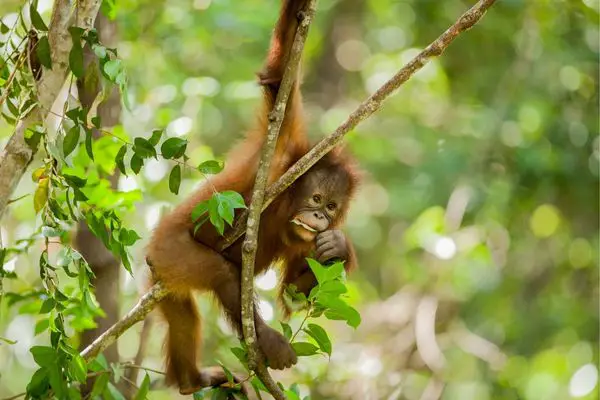
The orangutan is a great ape, but is an endangered species due to the rapid destruction of their habitat. As more forests disappear, it is inevitable that their numbers will decrease.
Orangotans are the largest of the tree-dwelling (arboreal) apes, and this makes them somewhat better at competing against other species for the same food items.
Do They Eat Meat?
The diet of an orangutan consists mostly of fruit but can also include leaves, shoots, bark, flowers, and smaller animals but mostly insects; they do not eat meat from larger animals as real carnivores do.
However, their large canine teeth, which are mainly used to determine their social hierarchy, suggest that they may have done so at some point during their evolution into a vegetarian diet.
Fruit makes up about two-thirds of an orangutan’s diet. During different times of the year different fruits are available, so orangutans have to be able to identify which fruits are ripe and which ones aren’t.
They will occasionally seak out insects to supplement their vegetarian diet with some extra protein in minerals. They prefer termites as they can gather many termites in a short amount of time.
And as you will see later in this post, they are quite good at using tools for fishing – and not only when it comes to termites!
Are Orangutans Herbivores or Carnivores?
As a biologist with experience studying primates, including orangutans, I can confidently state that orangutans are primarily herbivores. They consume a wide variety of plant matter, such as fruits, leaves, bark, and flowers, which make up the majority of their diet. These intelligent apes are known to spend a significant amount of time foraging for vegetation in the tropical rainforests they call home.
However, it is important to note that orangutans do display some degree of dietary flexibility, and there have been occasional observations of them consuming insects.
They have been observed feeding on termites, ants, and other small invertebrates when these food sources are readily available. Orangutans have been known to use tools, such as sticks, to extract insects from tree crevices, demonstrating their resourcefulness in acquiring this alternative food source.
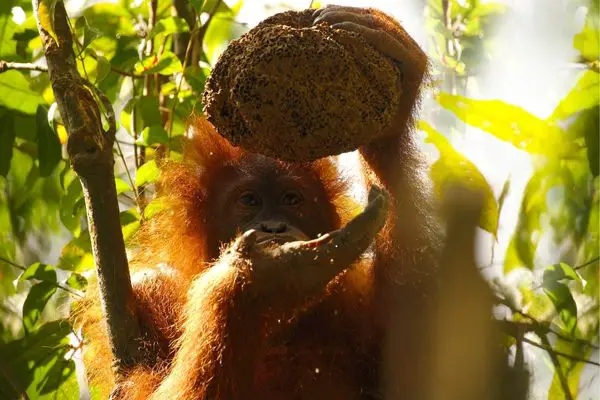
Furthermore, orangutans have been witnessed catching and eating fish, which is a behavior that sets them apart from other great apes.
These remarkable primates have been observed wading into rivers and using their hands or tools to catch fish swimming close to the water’s surface. This behavior has been documented in both wild and captive orangutans, suggesting that it is a natural and adaptive behavior for them.
While the consumption of insects and fish by orangutans is intriguing, it is essential to keep in mind that these instances are relatively rare and do not constitute a significant portion of their overall diet.
The primary food items for orangutans are plant-based, with fruits being particularly important due to their high caloric content. The consumption of insects and fish by orangutans appears to be opportunistic rather than a regular dietary strategy.
As a biologist who has had the privilege of observing orangutans in their natural habitat, I can attest to their fascinating feeding behaviors.
I have marveled at their ability to select and manipulate various plant parts to extract nutritious food. While I have not personally witnessed orangutans consuming insects or fish, I have spoken to colleagues who have had such experiences in the field.
In conclusion, orangutans are primarily herbivores, relying on a diverse array of plant-based foods. While they have been observed to consume insects and catch fish, these behaviors are relatively rare and opportunistic.
The ability of orangutans to adapt their diet in certain circumstances showcases their cognitive flexibility and resourcefulness, but it does not change their classification as primarily herbivorous primates.
What is the Role of Orangutans in the Ecosystem?
Orangutans play an important role in the ecosystem by dispersing seeds and maintaining the health of the forests they live in.
As seed dispersers, orangutans help to regenerate the forest by spreading seeds from the fruits they eat.
This not only benefits the trees and other plants in the forest, but also the animals that depend on them for food and shelter.
As omnivores or herbivores, orangutans help to control populations of plants and animals in the forest. By eating different types of plants, they are able to regulate the growth of certain species and prevent them from taking over.
This maintains a healthy balance in the forest ecosystem that is necessary for all its inhabitants.
Are Orangutans Carnivores, Herbivores or Omnivores?
Orangutans are omnivores because they eat both plants and animals. However, the diet of the orangutan is varied and in the summer orangutans may consume up to around 99% of their calories from fruit and plants, which they get from the forest canopy.
Orangutans usually consume more calories during colder months when they eat 60% of their calories from fruit and the remaining 40% from plant parts such as flowers, young shoots and leaves! As you can see from these numbers, very little is eaten as insects and other animals.
When Are Orangutans Carnivores?
Orangutans can act as carnivores but do so very rarely. Orangutans have been known to eat meat on occasion when plant food is scarce or if they happen to encounter a weak animal or a fresh carcass.
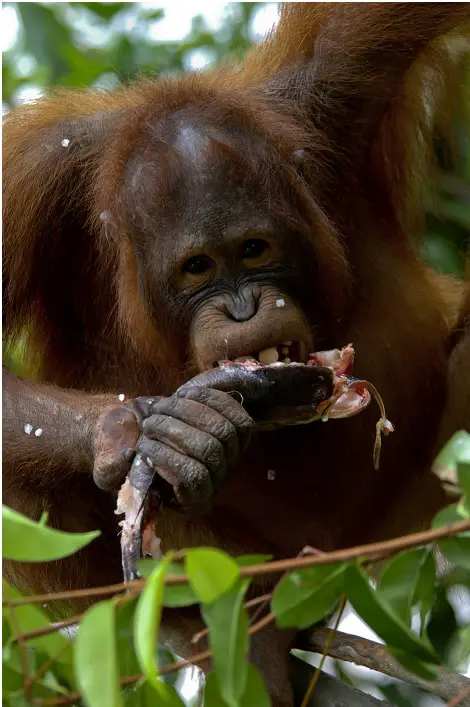
They generally do not actively hunt though, and would never attack larger animals for food, but there are rare examples of orangutans eating other primates or even using tools to catch and eat fish!
When Are Orangutans Omnivores?
Orangutans are omnivores when they feed on the occasional insect or two as a supplement to their main vegetarian diet.
Is an Orangutan a Producer, Consumer or Decomposer?
Orangutans are consumers because they eat other living things. Orangutans are omnivores because, although their diet consists primarily of plants, they also eat animals. They are considered primary consumers because they only eat plants.
What Type of Consumer is an Orangutan?
Orangutans are primary consumers because they only eat plants. Generally, herbivores are primary consumers, omnivores secondary consumers and carnivores are tertiary consumers.
Can Orangutans be Considered Scavengers?
No. Orangutans do not eat dead or decaying matter and are therefore not scavengers.
Where are Orangutans in the Food Chain?
Orangutans are omnivores, which means they eat both plants and animals. This places them in the middle of the food chain, on the 2nd and third trophic levels in the energy pyramid.
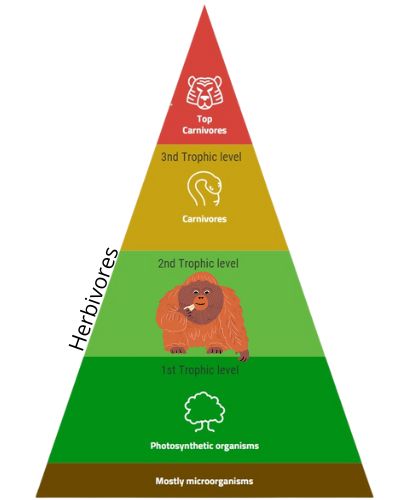
Only when they eat other animals can they be considered secondary consumers on the 3rd trophic level.
Are Orangutans Autotrophs or Heterotrophs?
Orangutans are heterotrophs because they eat other living organisms. Practically no animals are autotrophic because animals do not get their energy directly from the sun like plants do. That is, animals like orangutans cannot make their own energy!
What Animals Hunt and Eat Orangutans?
due to their large size and arboreal lifestyle, orangutans are not easy prey to most animals.
Conclusion
In this blog post I have looked into the orangutan habitat and the feeding and dietary habits of this great ape, but their diet is actually quite similar to other primates in the rainforest.
Orangutans are either omnivores or frugivores (a type of herbivore), depending on which expert you ask. But they all agree that orangutans are not carnivores. The majority of their diet consists of fruit, but they also eat leaves, bark, insects, and even bird eggs on occasion. Because they play such an important role in seed dispersal, orangutans are critical to the health of the rainforest ecosystem.
Orangutans are the largest arboreal primates in the world, and also one of the smartest and most fascinating primates.
A recent study has even found evidence that orangutans will go into the water to catch fish, and they may even do so using a spear!
Orangutans have a diverse diet based on fruit, but also include insects (ants and termites), and small vertebrates such as birds, rodents and lizards. But they have once been observed to eat other primates:
Orangutans have such a complex social system, with females and males, and different social groups with different “roles” such as dominant male or female, or usually, it is the female who dominates.
Orangutans are intelligent, social and fascinating creatures and I hope you can see why it is so important to protect and conserve habitats where orangutans live so that they can survive and flourish.
To see how another large primate feeds check out my post on the feeding behavior of the gorilla!
References
Russon, A.E., et al., Orangutan fish eating, primate aquatic fauna eating, and their implications for the origins of ancestral hominin fish eating, Journal of Human Evolution (2014). http://dx.doi.org/10.1016/j.jhevol.2014.06.007

